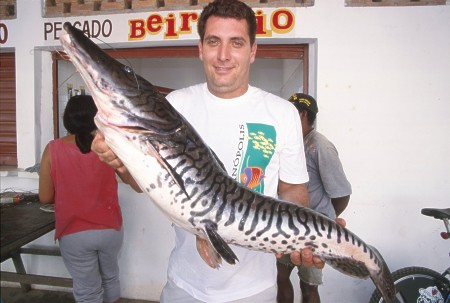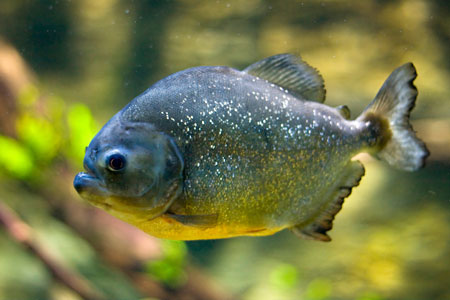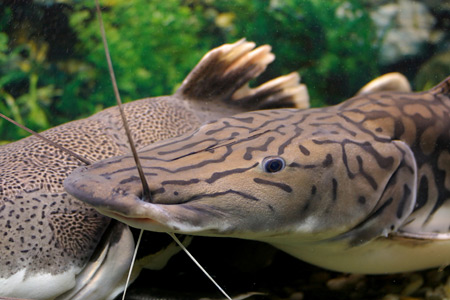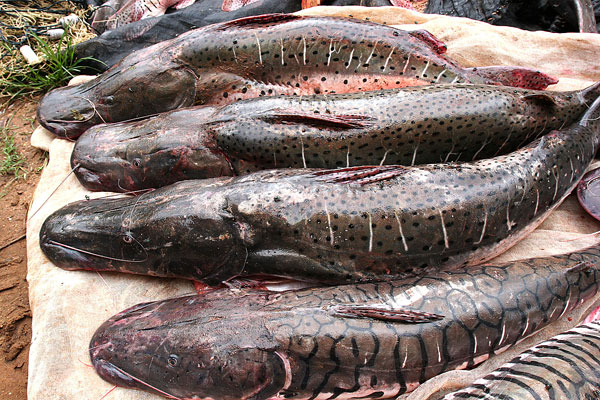Pintado
- the Jaú (or Gilded Catfish) which reaches 1.4m
- the Pirarara (or Red-tailed Catfish) which reaches 1.8m, and
- the Paraíba reaches up to 3m. Not common in the Pantanal, but present in greater numbers in the Araguaia river in eastern Mato Grosso and further north in the Amazon region.
Behaviour and Habitat
Both species are migratory. Those in the Pantanal are believed by make long annual migrations through the interconnected Paraná-Paraguay river systems - descending the rivers into southern Brazil, Uruguay and northern Argentina. They tend to stick to larger waterways and deep lakes - although they may extend into smaller river systems and flooded areas, particularly when breeding. They prey on other smaller fish, and are reputed to be primarily nocturnal hunters - leaving the deep riverbeds to hunt on shallow sandbars, entrances to streams, and around sunken vegetation.
Pintado and Cachara feed on smaller fish such as electric knifefish (tuvira), cichlids, loricariids, and characins. They may consume on other fish such as sábalos, and bogas. Opportunistic feeders, they may also feed on crustaceans such as crabs or shrimp.
Females are the larger of the two sexes - growing at a faster rate than the males. However, males are more numerous with a proportion of approximately three males to each female.
Close-up of two other closely related species, Pseudoplatystoma reticulatum from the Amazon region. These are similar to Pantanal species but differ in markings. Credit: iStock/dmitriyd.
Economic Importance
Pintado and Cachara are a popular eating fish due to their size, and the excellent quality of their meat with few stray bones. Both, along with the five other species in the Pseudoplatystoma genus, play an important role across South America’s regional economies. They’re an important food source for local residents living alongside the regions rivers, a coveted trophy for visiting sports fishermen, and are heavily targeted for commercial fishing. Within just a single province of Argentina, Entre Rios, its estimated that around 27,000 tonnes of Pseudoplatystoma species are harvested each year - comprising 70 to 80% of the total catch.
Because of the species’ popularity, some organisations are now working on artificial breeding and aquaculture programmes for commercial sale and to supplement wild populations.
Scientific Name
Pseudoplatystoma corruscans
Pseudoplatystoma fasciatum

Local Name
Surubim-Pintado or
Surubim-Cachara

Description
Large catfish, up to 1 m in length. Typically dark grey-brown in colour with a lighter underside. Species can be distinguished by their markings: The Pintado has dark spots, whereas the Cachara has dark transverse stripes. Both species have a long flattened head and nose (hence the english name, Shovel-nosed Catfish).
Notes for Fishing
Pintado and Cachara naturally feed on smaller fish meaning that natural baits such as tuvira (knifefish), curimbatá, piau and worms are best - although artificial baits have been known to work. Although primarily a nocturnal hunter, usually occupying deeper parts of the river - Pintado and Cachara can be sometimes be caught on shallow sandbars. Their large size and power means they can take considerable effort to reel in. When hooked they also tend to try hiding under logs and rocks. Once caught they should be handled with care as Pintado and Cachara have spines in the fins.
Minimum legal size to catch is 80 cm.
Reproduction
The reproduction appears linked to flooding - with the likelihood that flooded regions serve as an important nursery. However, as a result of dams being constructed across many major South American rivers, land development and dredging, in conjunction with overfishing and degraded water quality, the numbers of these fish appear to be in significant decline. When breeding, Pintado and Cachara females have been reported to swim upside down near the water surface - releasing eggs which are then fertilized by several males swimming over her abdomen in erratic patterns. The behaviour is repeated several times a day by each female.
Conservation and Threats
Although not formally recognised as threatened, Pintado and Cachaca numbers are in decline through overfishing - and the average size caught is reportedly much smaller than in the past. Because of their value they're targeted by illegal fishers in protected areas, during the piracema spawning period, or simply by fishermen exceed their catch limit. Destruction of natural environment also appears to be having a significant impact.
Quick Facts
- Although they don't swim together in schools like other fish, pintado and cachara gather at certain points of the rivers, especially among the branches of fallen trees.
- They are said to be curious - even allowing divers or swimmers to get close.
An illegal catch of Pintado and Cachara confiscated by IBAMA (Brazil's Environmental Protection Agency) during the Piracema period in the Cuiabá river. Credit: Lenine Martins/Secom-MT








Banner image: Surubim catfish (iStock/dmitriyd).
Footer images: Piranha teeth (Shutterstock/Chris Howey); Red-Bellied Piranha (Shutterstock/kostudio); Cachara catfish in Pantanal market (Andrew Mercer)


Pantanal Escapes